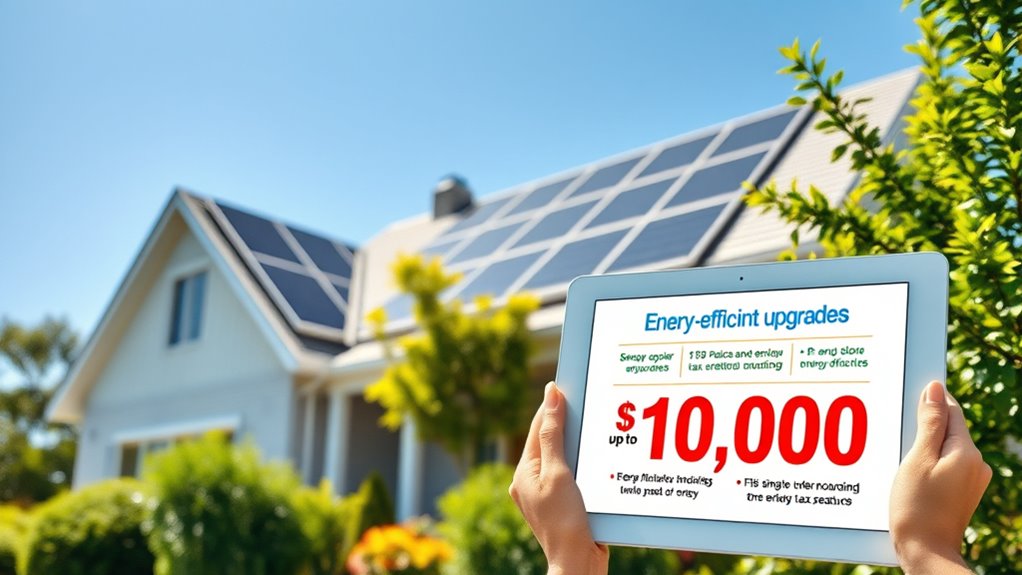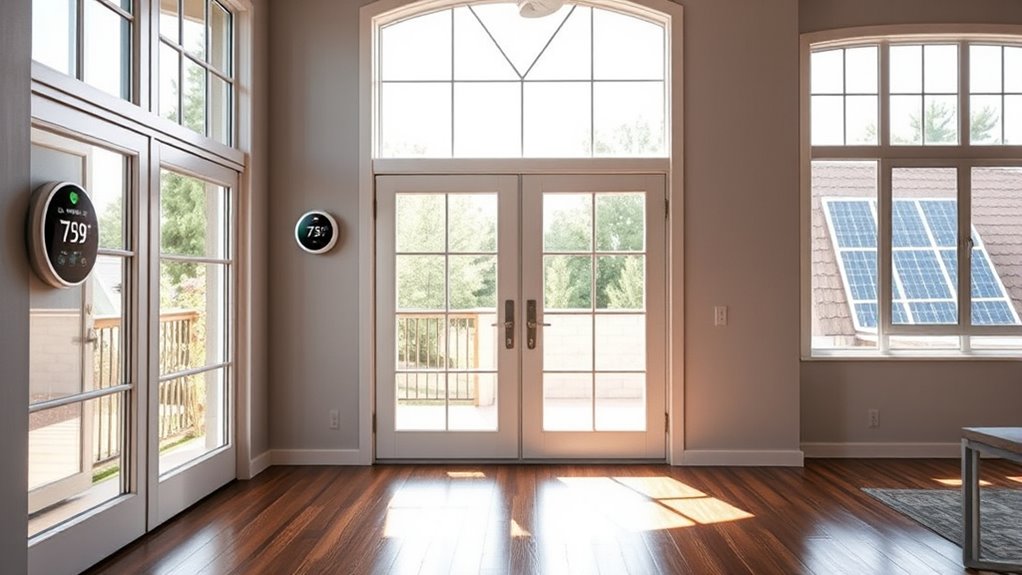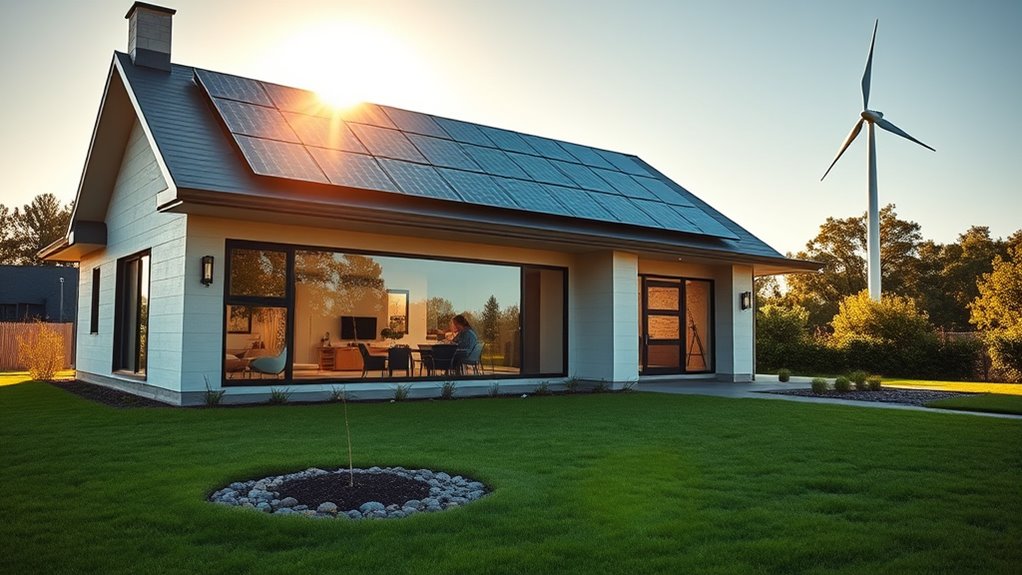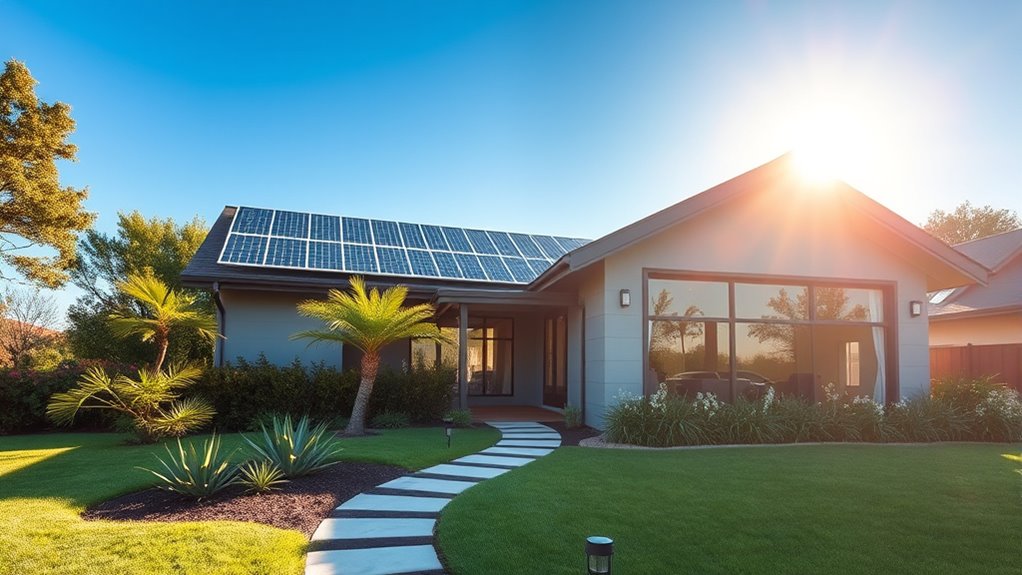You can claim up to $10,000 in federal tax credits by investing in qualifying energy-efficient home upgrades, like insulation, smart windows, and ENERGY STAR-certified systems. To maximize your benefits, verify your improvements meet specific energy standards, gather all receipts and certifications, and accurately complete IRS Form 5695. Proper documentation and planning can help you take full advantage of these incentives—learn how to do it step by step to boost your savings.
Key Takeaways
- The federal energy-efficient home credit offers up to $3,200 annually, with some items qualifying for additional rebates, totaling potential savings over $10,000.
- Qualifying upgrades include insulation, ENERGY STAR-certified appliances, heat pumps, and energy-efficient windows meeting specific standards.
- Proper documentation, certifications, and receipts are essential for claiming the credit on IRS Form 5695.
- Combining federal credits with state and utility rebates can maximize total benefits beyond $10,000.
- Maintaining organized records and verifying product certifications ensure full claim eligibility and simplify the claiming process.
Understanding the Federal Tax Credit Structure and Limits

Are you clear on how the federal tax credit for energy-efficient home improvements functions? The credit equals 30% of qualifying expenses made after January 1, 2023, with no lifetime dollar limit, allowing you to claim it annually until 2032. However, tax credit caps restrict your benefits: a maximum of $3,200 per year, with specific limits like $1,200 for windows, doors, insulation, and audits, and up to $2,000 for heat pumps and water heaters. Manufacturer verification is essential; only products from qualified manufacturers that meet ENERGY STAR standards qualify, and starting in 2025, you must report the Product Identification Number (PIN) for each item. These limits help ensure you maximize your savings within the program’s guidelines. Additionally, understanding cookie management can help enhance your online experience while researching energy-efficient products.
Qualifying Home Improvements for Maximum Savings

To maximize your energy-efficient home credits, focus on improvements that meet established standards and guidelines. Tax policy favors upgrades that adhere to energy standards like ENERGY STAR, ensuring your investments qualify for maximum savings. Insulation upgrades should meet specific R-value requirements and be installed in attics, walls, floors, or ceilings to reduce heat loss effectively. Air sealing with caulking or weather stripping around windows and doors also qualifies, provided it lowers air leaks. When replacing heating, cooling, or water heating equipment, choose ENERGY STAR-certified models like heat pumps, furnaces, or water heaters. Additionally, installing energy-efficient windows, doors, or skylights that meet current standards can yield credits. Staying within these guidelines helps you claim the highest allowable credits and improve your home’s energy efficiency, ensuring you optimize your home’s energy performance.
How to Calculate Your Potential Tax Credits

Calculating your potential energy-efficient home tax credits involves understanding the basis for the credit and the applicable percentage. You start with the cost calculation, which is 30% of qualified expenses for improvements made in the taxable year beginning January 1, 2023. Eligible costs include energy-efficient upgrades, residential energy property, and home energy audits. To determine your credit, add up all expenses paid or incurred for qualifying property installed within the year, ensuring they meet the eligibility criteria such as efficiency standards and manufacturer certification. Remember, there’s no lifetime limit, but the annual maximum credit is capped at $1,200, with specific caps for items like doors, windows, and audits. Accurate documentation and receipts are essential for proper calculation and reporting on IRS Form 5695. Incorporating organic and natural juices into your home can also support a healthier lifestyle alongside energy-efficient upgrades.
Step-by-Step Guide to Claiming Your Credits

Starting the process of claiming your energy-efficient home credits involves verifying your eligibility, gathering proper documentation, and accurately completing IRS forms. First, confirm your home qualifies by meeting efficiency standards, using databases like Energy Star, and ensuring electrical systems meet the National Electric Code. Next, collect receipts, certifications, and proof of installation to support your claim, especially if home automation upgrades or property valuation changes are involved. The IRS may require documentation for certain upgrades to substantiate your claim. Additionally, staying informed about energy-efficient standards can help you ensure your improvements qualify and maximize your credits.
- Confirm your property’s eligibility and efficiency standards before purchase
- Keep detailed records of all energy-efficient improvements
- Use manufacturer’s certifications and Energy Star certificates as proof
- Accurately complete IRS Form 5695, including product IDs for 2025 and beyond
- Transfer the credit to your tax return and file on time
This ensures a smooth claiming process and maximizes your benefits.
Strategic Upgrades to Maximize Your Benefits

To maximize your home energy credits, focus on high-impact upgrades like heat pumps, water heaters, and insulation, which offer larger annual limits. Combine multiple incentives by planning your improvements over time, guaranteeing you stay within caps and get the most benefit each year. Carefully track costs and certifications to ensure each upgrade qualifies and you claim the full credits available. Additionally, understanding the energy efficiency standards can help you select upgrades that meet program requirements and maximize your incentives.
Prioritize High-Impact Improvements
Focusing on high-impact home upgrades guarantees you get the most energy savings and financial benefits from your investments. Prioritize improvements like upgrading your HVAC system with ENERGY STAR-certified heat pumps and installing smart thermostats to optimize energy use. Replacing outdated systems can cut energy consumption by up to 50%, providing substantial savings. Additionally, enhancing home insulation and air sealing reduces heat loss and gain, lowering your bills by 10–50%. Upgrading windows and doors with ENERGY STAR-certified options improves thermal performance and increases home value. Consider these key upgrades to maximize your benefits:
- Upgrade to energy-efficient HVAC systems
- Install smart thermostats for dynamic control
- Improve home insulation and air sealing
- Replace old windows and doors
- Focus on high-impact, energy-saving solutions
Combine Multiple Incentives
Combining multiple incentives can considerably boost your savings when upgrading your home’s energy systems. By stacking federal, state, and utility rebates, you can lower costs on projects like solar panel installations, home automation systems, or weatherization measures. For example, installing solar panels with battery storage might qualify for the Residential Clean Energy Tax Credit, while utility rebates could help cover equipment costs. Upgrading to renewable resources and improving home automation can also maximize incentives, making your home more efficient and comfortable. Keep in mind that rules vary, and some incentives may have restrictions or caps. Carefully coordinate your upgrades to ensure eligibility for multiple benefits, and consult program guidelines to avoid disqualification. Proper stacking allows you to claim up to $10,000 or more in combined credits and rebates. State energy offices can also assist in navigating complex incentive programs and ensuring you access all available benefits.
Recordkeeping and Documentation Requirements

Are you prepared to meet the recordkeeping and documentation requirements for the Energy-Efficient Home Credits? Proper documentation essentials are vital to substantiating your claim. You need detailed receipts, invoices, and proof of purchase, including installation dates and costs. Keep records of certifications, such as manufacturer-issued PIN or QM codes, to verify product qualification. Recordkeeping tips include documenting efficiency ratings—like Energy Star or CEE tiers—and guaranteeing electrical components meet the National Electric Code. Separate records are essential for multiple items, especially when caps apply. It’s also indispensable to retain copies of IRS Form 5695 and supporting documents in case of an audit. Maintaining organized, accurate records ensures your claim is valid and simplifies the process of claiming your energy-efficient home credits. Additionally, keeping digital copies and backing up your records can prevent loss and facilitate easy access during tax season. Staying informed about home improvement best practices can further streamline your documentation process.
Long-Term Impact of Energy-Efficient Investments

| Benefit | Description |
|---|---|
| Increased property value | Enhances resale potential and market appeal. Regular maintenance of energy systems can further extend their lifespan and efficiency. |
| Lower energy costs | Reduced utility bills over years. Energy-efficient systems and appliances are designed to last longer, minimizing replacement costs. |
| Environmental sustainability | Cuts carbon footprint and resource use. Incorporating renewable energy options can amplify these benefits. |
| Energy system durability | Longer-lasting appliances and systems. Proper installation and routine inspections help maintain optimal performance. |
| Enhanced indoor comfort | Consistent temperatures and better air quality. Improved insulation and sealing contribute to these advantages. |
| Long-term financial savings | Investing in energy-efficient upgrades can lead to substantial savings over time by reducing ongoing expenses and increasing overall household affordability. |
Frequently Asked Questions
Can I Combine These Credits With State or Local Incentives?
Yes, you can combine federal energy-efficient home credits with state incentives and local rebate programs. These programs often stack with federal credits, boosting your savings on upgrades like solar panels or efficient HVAC systems. Just make sure to verify each program’s rules and keep proper documentation. Combining these incentives can markedly reduce your overall costs, making energy-efficient improvements more affordable and helping you maximize your benefits.
Are There Income Limits Affecting My Eligibility for These Credits?
Your eligibility for these energy-efficient home credits isn’t limited by income restrictions or eligibility thresholds. The IRS guidance states there are no explicit income limits, so anyone can claim the credit based on qualified expenditures. You don’t need to worry about income-based eligibility, but you do need to meet the specific product and installation requirements, keep proper documentation, and file IRS Form 5695 to claim your credit.
Do I Need to Hire Certified Professionals for Qualifying Installations?
You need to hire professionals with proper certification for certain installations. The IRS emphasizes installation requirements that specify the use of qualified, certified professionals for complex systems like heat pumps or central air units. This guarantees your installation meets standards, and your documentation is valid. By choosing certified experts, you comply with the certification and installation requirements, making it easier to claim your energy-efficient home credits and avoid potential issues with your tax claims.
How Do I Update My Records if I Sell My Home?
Imagine passing on a treasured story; you need to update your home documentation. When you sell, you should record the sale date and keep proof like the deed or closing statement. This guarantees your records are current and clearly show installation dates. Updating your record updates your claim rights, preventing confusion or duplication. Keep these records safe for future reference, especially if the IRS questions your energy-efficient upgrades.
Are Repairs or Maintenance Expenses Eligible for These Credits?
You can’t claim repair expenses or maintenance costs for energy-efficient home credits. These credits focus on new energy-efficient improvements like installing efficient windows, insulation, or heat pumps. Routine repairs or maintenance, such as fixing a furnace or patching a roof, don’t qualify. The program encourages upgrades that enhance your home’s energy performance, so only costs related to eligible new installations or replacements count toward the credits.
Conclusion
By claiming these energy-efficient home credits, you could save enough money to buy a spaceship or fund your dream vacation—it’s that big! Don’t miss out on the chance to slash your energy bills and transform your home into a powerhouse of savings. Act now, stay organized, and maximize your benefits—because this opportunity is so incredible, it could change your life forever! Your dream home of savings is just a claim away!









